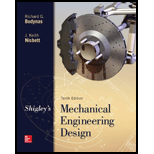
Concept explainers
For the gearset and conditions of Prob. 15-3, find the power rating based on AGMA surface durability.
15-3 An uncrowned straight-bevel pinion has 30 teeth, a diametral pitch of 6, and a transmission accuracy number of 6. The driven gear has 60 teeth. Both are made of No. 30 cast iron. The shaft angle is 90°. The face width is 1.25 in, the pinion speed is 900 rev/min, and the normal pressure angle is 20°. The pinion is mounted outboard of its bearings and the bearings of the gear straddle it. What is the power rating based on AGMA bending strength? Note: For cast iron gearsets reliability information has not yet been developed. We say that if the life is greater than 107 revolutions, then set KL = 1, CL = 1, CR = 1, KR = 1, and apply a factor of safety. Use SF = 2 and SH =
Want to see the full answer?
Check out a sample textbook solution
Chapter 15 Solutions
Shigley's Mechanical Engineering Design (McGraw-Hill Series in Mechanical Engineering)
- A commercial enclosed spur gearset has 22 teeth on the pinion and 60 teeth on the gear. The pressure angle is 20° and the overload factor Ko =1. The diametral pitch is 8 teeth/in and the face width is 5 in. The pinion speed is 1000 rev/min and its cycle life is to be 10° revolutions at a reliability R =0.50. The quality number is 5 and the tooth are crowned. The material is a through-hardened steel, grade 2, with Brinell hardnesses of 250 core and case of both gears. For a conservative design and bending stress design factor of 2, rate the pinion (power) for these conditions using the AGMA method.arrow_forwardNonearrow_forward14-23 A spur gearset has 17 teeth on the pinion and 51 teeth on the gear. The pressure angle is 20° and the overload factor K, = 1. The diametral pitch is 6 teeth/in and the face width is 2 in. The pinion speed is 1120 rev/min and its cycle life is to be 10" revolu- tions at a reliability R = 0.99. The quality number is 5. The material is a through- hardened steel, grade 1, with Brinell hardnesses of 232 core and case of both gears. For a design factor of 2, rate the gearset for these conditions using the AGMA method.arrow_forward
- Two 20º full-depth steel gears are heat treated to BHN=350. AGMA Quality No.8 Pinionturns 860 rpm. N1=24c; N2=96; Pd=4, and b=2in. Find the horsepower the gears aretransmitting. Ans: hp=77.2arrow_forwardI need the answer as soon as possiblearrow_forwardI need the answer as soon as possiblearrow_forward
- What is the surface strength geometry factor, I? This should be an exact value.arrow_forwardA gear set with a 20-tooth input pinion and a 42-tooth gear has a diametral pitch of 4 teeth/in. the pinion speed is 200 rpm with an input torque of 170 in-lbf. Which component of the load contributes to the transmitted power and what is it’s magnitude? Choose answer below Radial load 68lbf Tangential load 68lbf Radial load 136 lbf Tangential load 136 lbf None of the abovearrow_forwardProvide the complete step-by-step solution, given data, conversion of units, and sketch for this problem. A turbine at 30,000 rpm is used to drive a reduction gear delivering 3 hp at 3,000rpm. The gears are 20 degrees involute herringbone gears of 28 pitch and 2 1/8 ineffective width. The pinion has 20 teeth with a helix angle of 23 deg. Determine theload normal to the tooth surface. A. 20.4 lbs B. 24.4 lbs C. 28.4 lbs D. 32.4arrow_forward
- Find the gear ratio, circular pitch, base pitch, pitch diameters, pitch radii, center distance, addendum, dedendum, whole depth, clearance of a gearset with the given parameters. A diametral pitch is 6 teeth per inch, 20°-pressure-angle, 19-tooth pinion and a 37-tooth gear. Assumptions: The tooth forms are standard AGMA full-depth involute profiles.arrow_forwardA gearset has the following parameters: diametral pitch = 8, pressure angle = 20°, 19-tooth pinion meshed with 37-tooth gear. Find the gear ratio, circular pitch, base pitch, pitch diameters, center distance, addendum, dedendum, whole depth, clearance, and the outside diameters.arrow_forwardA 14 teeth pinion gear drove a 40 tooth gear and stalled with a peak 376.1g being lifted from the scale. What was the torque at the motor shaft when this occurred? (The output pulley had a diameter of 1.25”)arrow_forward
 Elements Of ElectromagneticsMechanical EngineeringISBN:9780190698614Author:Sadiku, Matthew N. O.Publisher:Oxford University Press
Elements Of ElectromagneticsMechanical EngineeringISBN:9780190698614Author:Sadiku, Matthew N. O.Publisher:Oxford University Press Mechanics of Materials (10th Edition)Mechanical EngineeringISBN:9780134319650Author:Russell C. HibbelerPublisher:PEARSON
Mechanics of Materials (10th Edition)Mechanical EngineeringISBN:9780134319650Author:Russell C. HibbelerPublisher:PEARSON Thermodynamics: An Engineering ApproachMechanical EngineeringISBN:9781259822674Author:Yunus A. Cengel Dr., Michael A. BolesPublisher:McGraw-Hill Education
Thermodynamics: An Engineering ApproachMechanical EngineeringISBN:9781259822674Author:Yunus A. Cengel Dr., Michael A. BolesPublisher:McGraw-Hill Education Control Systems EngineeringMechanical EngineeringISBN:9781118170519Author:Norman S. NisePublisher:WILEY
Control Systems EngineeringMechanical EngineeringISBN:9781118170519Author:Norman S. NisePublisher:WILEY Mechanics of Materials (MindTap Course List)Mechanical EngineeringISBN:9781337093347Author:Barry J. Goodno, James M. GerePublisher:Cengage Learning
Mechanics of Materials (MindTap Course List)Mechanical EngineeringISBN:9781337093347Author:Barry J. Goodno, James M. GerePublisher:Cengage Learning Engineering Mechanics: StaticsMechanical EngineeringISBN:9781118807330Author:James L. Meriam, L. G. Kraige, J. N. BoltonPublisher:WILEY
Engineering Mechanics: StaticsMechanical EngineeringISBN:9781118807330Author:James L. Meriam, L. G. Kraige, J. N. BoltonPublisher:WILEY





